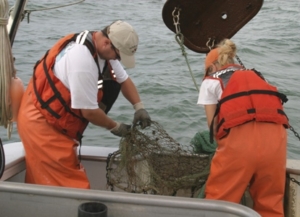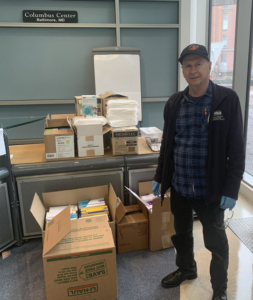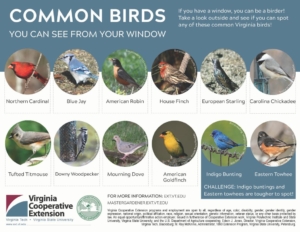How member institutions are managing under the new COVID-19 restrictions
As states across the U.S. have issued social distancing orders to slow the spread of the COronaVIrus Disease 2019 (also known as COVID-19), universities and research centers have had to make major adjustments to their scientific operations. Like everybody else, this is also true for the member institutions that make up the Chesapeake Research Consortium. “Collaborative Research around the Bay” or CRaB is one of our most popular newsletter sections, where the stories feature collaborative research updates from multiple member institutions. For this newsletter, however, we are changing the section to “COVID-19 Response around the Bay” and shifting our focus to how COVID-19 is impacting our member institutions and how they are responding in hopes that this will provide assistance to others as we navigate this new normal.
Even during times of great uncertainty, CRC member institutions have worked diligently to keep research alive and offer important services to their communities. Inspired by these actions, the CRC has assembled a list of guidelines, information, and stories that showcase how partner institutions are advancing research, teaching remotely, promoting wellness, sharing science, and helping those in need during this crisis. While this is a growing list on how COVID-19 is impacting education and research, we understand that the effects of this pandemic on colleges and universities are multifaceted and complex. We hope that members of this consortium find this resource helpful, and we encourage contributions to this compilation. We also hope that our community stays safe and healthy in this difficult time.
Keeping essential research going
Conducting research in the field or within a laboratory often puts scientists in close contact with each other, increasing the likelihood of spreading the virus. As such, member institutions have taken preventive measures to minimize the risk of infection while keeping essential research activities running, including projects focused on the Chesapeake Bay and its watershed. This has involved significantly ramping down on-site activities, shifting to working from home, and making contingency plans for conducting research while adjusting to this new normal. “The underlying principle is to help ensure that our healthcare systems do not become overwhelmed,” notes the Penn State Office of the Senior Vice President for Research in an announcement. “Together, we need to do everything we can to curtail campus activities to the barest minimum levels.”

Removing an old crab pot that was collected in the trawl. Credit: VIMS
A very small number of staff from member institutions have been allowed on campus for essential research activities. The Virginia Institute of Marine Science (VIMS) has designated areas of priority for their research activities, including caring for animals and cultures of special significance, supporting sensitive equipment, overseeing time-sensitive work for state agencies and industries, and processing “highly valuable” time-sensitive samples. However, the number of researchers on institution campuses is kept to a minimum, and they are still following stringent social distancing protocols.
Due to these restrictions and narrowed research goals, institutions have had to suspend some projects and field work campaigns for the time being. This includes VIMS’ Juvenile Fish and Blue Crab Trawl Survey, a research endeavor that has been collecting data for more than 65 years to better understand the Chesapeake Bay’s underwater ecosystem. The program is the longest continuously running trawl survey in the U.S., but has halted operations in response to the pandemic, according to an article from the Virginia Mercury.
Pausing research projects, like the Juvenile Fish and Blue Crab Trawl Survey, means there will be gaps in Chesapeake Bay studies that might never be filled in. This is especially challenging for field work that can only be done during a certain time of the year. Some long-term projects can cope with a few months of missing data, while for others, such research reductions could have a high cost. Kimberly Komatsu, a senior scientist at the Smithsonian Environmental Research Center (SERC), commented on the impacts of research restrictions in an article by the Capital Gazette: “Losing even one year of data in these long-term datasets can hamper our ability to understand the processes that underlie environmental dynamics, and the services that humans depend on like food production, climate regulation, and pest and disease control.”
Shifting to remote research
While access to facilities and field work are limited, many member institutions have instead directed scientists to prioritize research activities that can be done virtually, such as working on data processing, proposals, publications, and reviews.
For some scientists, their research can still progress remotely. One example is the National Ballast Information Clearinghouse, a joint program operated by SERC and the U.S. Coast Guard that focuses on reducing the spread of non-native species in coastal systems through ship ballast water discharge. The project involves analyzing reports that are submitted by ships electronically, so SERC researchers are still able to collect and process this data.
Others are brainstorming new research opportunities that can be accomplished while working from home. For instance, SERC hosts several research and public engagement internships throughout the year, with a new cohort expected to begin in mid-June. Instead of cancelling these programs, the center’s scientists and outreach staff are aiming to find new projects that can be done remotely with data that has already been collected over time.
Putting community first during COVID-19
While the pandemic has introduced several research complications, member institutions have been exploring ways to be a force of good for those in need. “We are reaching out to serve the community around us, offering emergency supplies to local health departments and volunteering in local food banks,” said Peter Goodwin, the president of UMCES, in a statement.

IMET Director Russell Hill with boxes of personal protective equipment donations for the University of Maryland Medical System. Credit: UMCES
Several universities and research centers are donating and manufacturing medical supplies to nearby hospitals and health centers. This includes N95 masks, bleach, nitrile gloves, disposable aprons, hand sanitizer, and reusable goggles. Some institutes, like Old Dominion University, Penn State University, Johns Hopkins University, the University System of Maryland, and Virginia Tech, are even using their facilities for designing and 3D printing personal protective equipment and ventilator components for healthcare workers.
Many universities have also been busy creating interactive digital tools for tracking important data related to the pandemic. These various platforms have served as an important resource for scientists, health experts, and the general public. Researchers at ODU’s Virginia Modeling, Analysis and Simulation Center have designed a program that gives a seven-day forecast of COVID-19 cases in Virginia counties. Scientists at the University of Maryland have developed a platform that maps social distancing compliance across the nation.
Johns Hopkins University (JHU) has gained global recognition for providing an online interactive dashboard that maps the spread of COVID-19 infections around the world in real time. The platform was developed in December 2019 by Lauren Gardner, a civil and systems engineering professor at JHU, with her graduate student, Ensheng Dong. “Given the popularity and impact of the dashboard to date, we plan to continue hosting and managing the tool throughout the entirety of the COVID-19 outbreak and to build out its capabilities to establish a standing tool to monitor and report on future outbreaks,” said Gardner and her colleagues in an article published in The Lancet.
Making science accessible for those at home

Practicing social distancing? Look out your window and see if you can spot these common Virginia birds! Credit: Virginia Cooperative Extension
Member institutions have also been developing digital outreach events and educational opportunities for those who are quarantining. For example, Virginia Tech researchers and Virginia Cooperative Extension Master Gardeners have put together some handy guidelines for birdwatching while practicing social distancing. UMCES has highlighted its Wave of Plastic Waste Inventory Activity, which helps students think about the impact of plastic pollution, especially within the Chesapeake Bay watershed. The full Wave of Plastic curriculum is available online, and the center plans on adding new activities and lessons in the next coming weeks.
Through its social media channels and Multimedia Resource Center, VIMS has provided an assortment of science explainers, virtual tours of research centers, after-hours lectures, and kid-friendly activities focusing on marine education. SERC has been updating and sharing some digital resources too, like their Ecosystems on the Edge video series, hands-on activities like orchid-gami, and online citizen science projects like Invader ID and Fossil Atmospheres.
